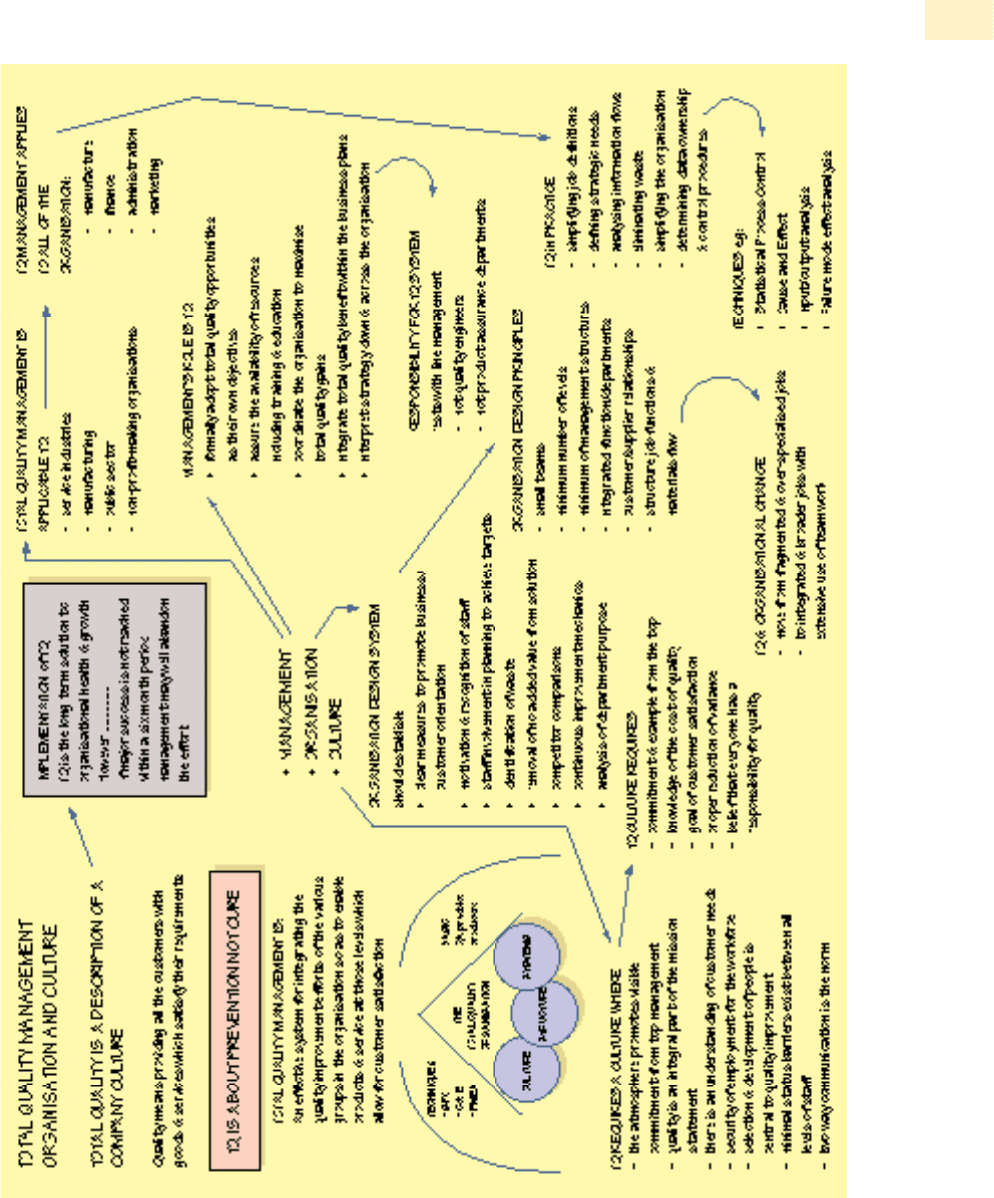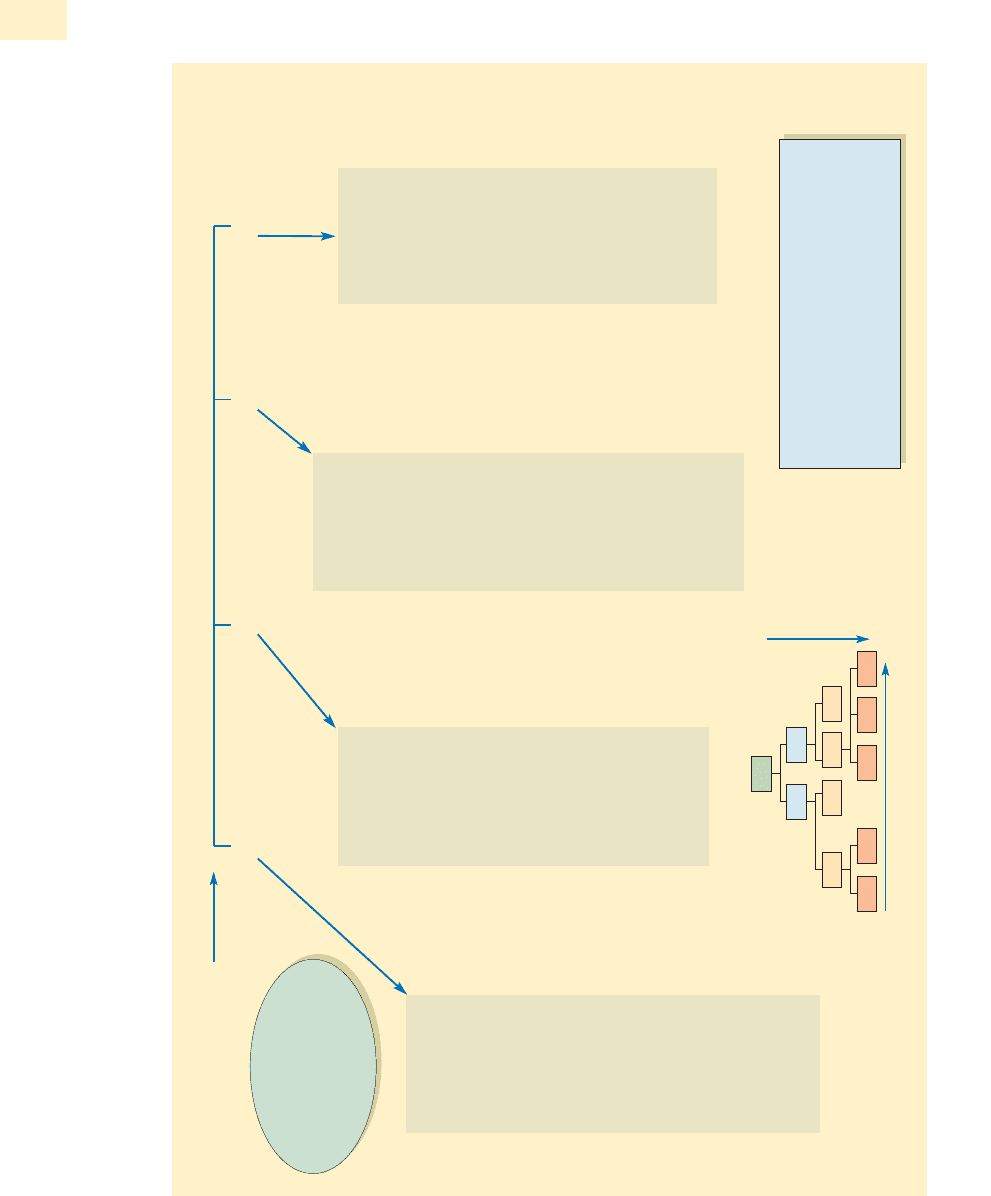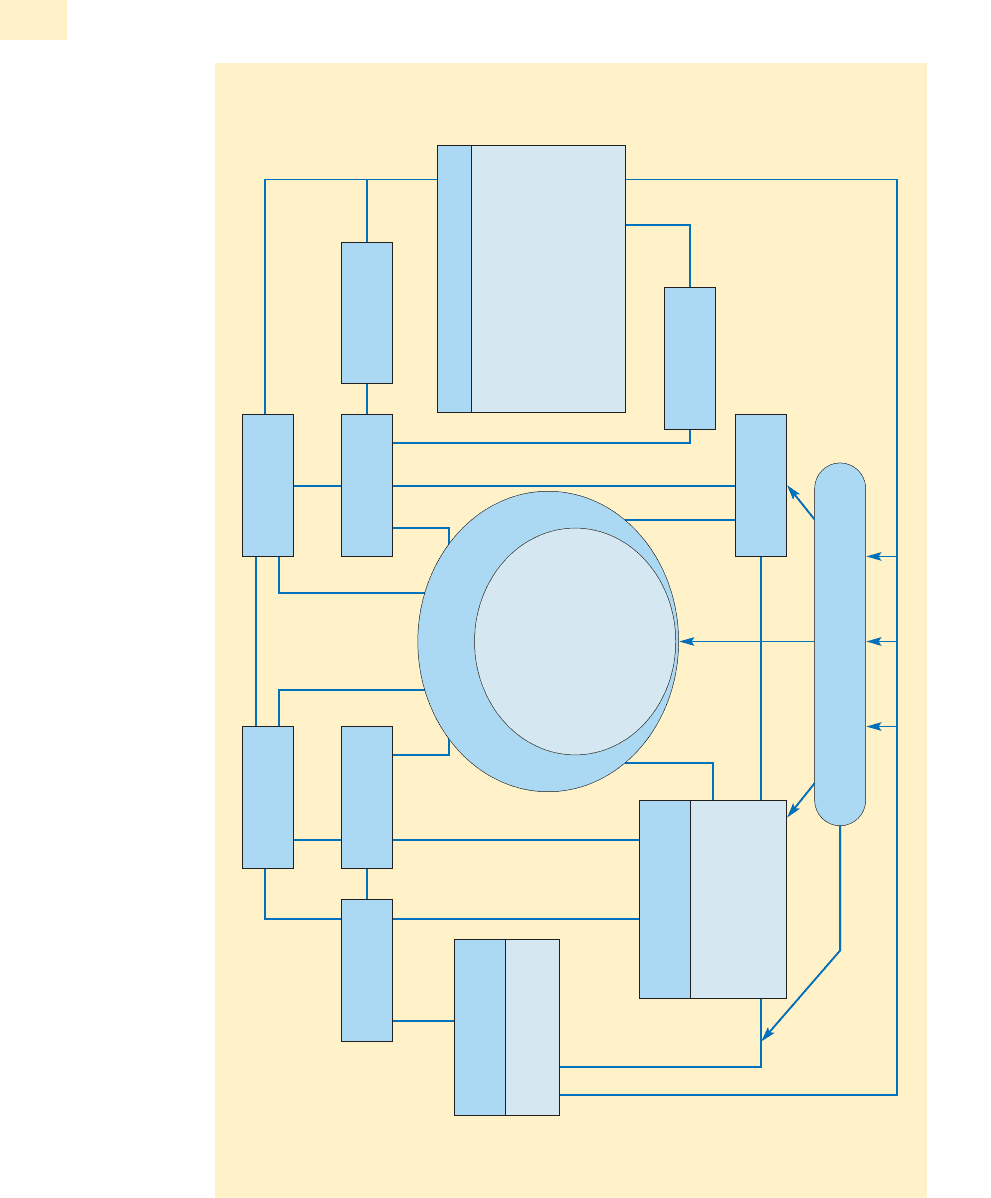Mullins L.J. Management and organisational behaviour, Seventh edition
Подождите немного. Документ загружается.


■ analyses every part of a process down to the smallest detail;
■ sees how every part of the process can be improved;
■ looks at how employees’ actions, equipment and materials can be improved; and
■ looks at ways of saving time and reducing waste.
68
According to the Kaizen Institute, it is a business strategy which involves everyone in
an organization working together to make improvements without large-scale capital
investments.
Kaizen is a culture of sustained continuous improvement focusing on eliminating waste in all sys-
tems and processes in an organization. The Kaizen strategy beginsand ends with people. With
Kaizen, an involved leadership guides people to continuously improve their ability to meet expec-
tations of high quality, low cost, and on-time delivery. Kaizen transforms companies into
‘Superior Global Competitors’.
69
Keyelements of TQM
The key elements of TQM have been identified by Pentecost as:
■ a total process involving all operations and management units in the organisation,
and led from the top;
■ the customer as king with every strategy, process and action directly related to sat-
isfying customers’ needs;
■ a greater emphasis on rational information collection and analysis using modern
technology where appropriate;
■ an emphasis on a different approach to looking at the costs of poor quality by
examining all processes in the organisation which add to costs;
■ a greater involvement of people, recognising that they are a great untapped
resource in most companies;
■ teamwork as crucially important, involving multi-discipline and multi-level work-
ing to solve problems and to meet customers’ needs; and
■ the requirements for creative thinking and the ability to think beyond the immedi-
ate job or work environment.
70
TQM emphasises the importance of people as the key to quality. Human resource man-
agement and quality management are converging to give total quality. It is lack of
communications and awareness that causes failures and costs. There has been too
much reliance on systems. Although systems are necessary, they are only as effective as
the people who design them.
71
Changes in the traditional organisation structure and
the increasing importance of effective work groups emphasise team-based management
as an essential element of TQM.
72
TQM requires the creation of a corporate identity
and a supportive environment. It involves setting the highest standards for quality at
lowest costs; effective training including teambuilding throughout the organisation;
integrating systems and technology with people; and the motivation, participation and
commitment of staff at all levels of the organisation.
73
Proper attention to human
resource issues is an essential requirement for the successful implementation of TQM.
74
James puts forward the contention that TQM initiatives will not succeed unless
rooted in a supportive Quality of Working Life (QWL) culture.
World standards of organisational effectiveness are not achievable without fully developed and
committed people at all levels within an organisation. New technologies, new systems, and new
concepts may, of themselves, produce some improvement in effectiveness and hence competi-
tiveness but even in the short term the improvement will be stunted without an organisation
culture which engenders commitment of people across the organisation.
75
The aim of a QWL culture is to create a fear-free organisation in which employee
involvement is pursued vigorously. It generates a high degree of reciprocal commit-
CHAPTER 23 MANAGEMENT DEVELOPMENT AND ORGANISATIONAL EFFECTIVENESS
965
The importance
of people

ment between the needs and development of the individual, and the goals and devel-
opments of the organisation. A QWL cultural underpinning anchors the development
of total quality and is essential to a successful TQM strategy.
A summary outline of total quality management organisation and culture is
presented in Figure 23.5.
The success of TQM
Almost inevitably, there are negative comments and criticisms about the concept of
TQM, and doubts about its value. Thomas, for example, suggests that the term Total
Quality Management is a bit of an oxymoron and that in all probability it would be
advantageous if the ‘M’ were to be removed.
Total Quality cannot be ‘managed’ in the traditional, i.e. supervise and control, sense of the word
because it involves factors such as commitment, purpose, vision and trust that are not amenable
to mechanistic prescription. Quality can, and must be, managed. Total Quality, however, must be
encouraged to evolve.
76
However, there are many success stories which give evidence of its benefits and effec-
tiveness.
77
Heller refers to the disillusion with, and backlash against, TQM which was
bound to come. ‘No technique has ever spread so far so fast – or so wide.’ However, he
makes the point that:
The successes, and many other European cases, however, are emphatic evidence that Total
Quality Management delivers – you can’t argue with the results.
78
And while recognising that TQM has been dismissed by some as just another fad,
Kreitner et al. believe that: ‘TQM principles have profound practical implications for
managing people today.’
79
Drummond puts forward an interesting debate on comparing the philosophies and
ideas of Deming with Taylor’s Scientific Management, and questions whether Deming’s
ideas are as radical as they seem. Drummond suggests that:
Clearly, ‘total quality management’ offers some new ideas. Whether these ideas have proved suc-
cessful is unclear … Moreover, much depends upon how success is measured. Different
measures can suggest differentconclusions. Another difficulty in assessing the effectiveness of
‘total quality management programmes’ is that organizations have implemented Deming’s ideas
selectively.
80
Allen and Kilmann raise the question: why aren’t TQM practices as effective as they could
be? The rise of Total Quality Management represents one of the biggest changes in the
past two decades in the way companies are managed. However, while many studies
have found that in general TQM has had positive effects on company performance,
reports of failure are surprisingly common in the press. Allen and Kilmann suggest that
the alignment of a company’s system of rewards is a critical ingredient in successful
organisational change and they investigate the relationship between reward practices,
and TQM. From a survey of managers, non-managerial and professional/technical staff
in a wide variety of organisations they conclude that the commonly held wisdom of
supporting TQM with only non-monetary rewards – such as certificates, letters of appre-
ciation, merchandise or celebration events – is not enough. If managers want better
performance from TQM they must implement supportive monetary reward practices.
Firms with such practices in place report stronger organisational performance.
81
966
PART 8 IMPROVING ORGANISATIONAL PERFORMANCE
TQM and
related reward
practices

CHAPTER 23 MANAGEMENT DEVELOPMENT AND ORGANISATIONAL EFFECTIVENESS
967
Figure 23.5 Total Quality Management Organisation and Culture
(Reproduced with permission of Training Learning Consultancy Ltd. Bristol.)

Another concept to have received much attention in recent years is that of business
process re-engineering (BPR). The pioneers of BPR are generally acknowledged as Hammer
and Champy who define it as:
The fundamental rethinking and radical redesign of business processes to achieve dramatic
improvements in critical, contemporary measures of performance, such as cost, quality, service
and speed.
82
Their approach has two principal features: (i) a completely fresh start, or blank sheet of
paper approach, to organisational redesign ignoring past history or present structure or
practices; and (ii) a process-orientation approach to organisational analysis centred
around a horizontal review of all activities involved in the process, or set of activities,
in the delivery of a product or service to the customer.
BPR is concerned with the total restructuring of the organisation. It starts from how
one would like the organisation to be and works backward in an effort to achieve real
gains in organisational performance, and delivery of products or services. Stewart sug-
968
PART 8 IMPROVING ORGANISATIONAL PERFORMANCE
An NHS trust on the south coast of England launched a
TQM initiative. It was based on the simple idea of lighting
fires of enthusiasm. The initial idea came from a chief exec-
utive who had spent a six-month scholarship at an
American business school. It worked by setting up small
quality-improvement groups and allowing staff to come up
with their own ideas for improvement. Money and
resources were available to help these ideas come to
fruition and there was plenty of evaluation to see what
could be learned from them. One of the initiatives was
based at a long-stay geriatric hospital which had long been
a source of negative press stories and the feeling in the
local population was that none of them would like to end
their days there.
Managers at the hospital set up a quality-improvement
group in the different wards. This was accompanied by a
delayering exercise, and empowering front-line nurses – or
named nurses as they are known – to take more decisions
and come up with ideas for improvement. The leader of this
project was a sister on the ward who wholeheartedly
endorsed the approach, but as she describes it, there were
teething problems to start with.
Over the first few months the named nurses kept
coming up and asking me for permission to do
things. I used to say to them: ‘Just go away and do
it. Come back and tell me when you have. I will sup-
port you.’ It was really difficult for them to
understand that they had the power to do something,
and there was a budget available for them to use.
However, after a while they really threw themselves
into it. We had a lot of new projects that really trans-
formed the hospital. A lot of the projects were simple
but really added to the quality of the people’s lives.
For instance, when we started asking patients what
they wanted, we found out that their wishes were
quite simple.
There were three main things. Firstly, they didn’t
have their own underwear. They all went into a sort of
communal melting pot. Also they weren’t given any
choice over the way their hair was cut. A person
would turn up on a certain day, and would cut their
hair all in the same way. A third source of irritation
was that they had no say in what they were called.
Some wanted to be referred to and spoken to as Mrs
Smith, for instance, others wanted to be known by
their first name.
We made changes immediately to put these things
right. But probably the most exciting example was
when a nurse came to me to say she wanted to take
one of our long-term residents to see her brother.
The resident had been with us for over 20 years, and
had not seen any member of her family in the whole
of that time. The nurse, on her own initiative, had
managed to track down this resident’s brother, and
had found he was in a nursing home just down the
coast. The nurse would never have done this in the
past. What happened next was the nurse hired a car,
which her husband drove, and the two of them made
contact with the brother, and they all went down to
visit him. They have done it several times since.
Before empowerment and TQM this never would
have happened.
(Source: S. Morris, G. Willcocks and E. Knasel, How to Lead a Winning Team,
The Institute of Management and Pitman Publishing (1995), pp.132–3.
Reproduced with permission from Kogan Page Ltd.)
Quality counts: TQM in an NHS trust
EXHIBIT 23.3
BUSINESS PROCESS RE-ENGINEERING (BPR)

gests that, unlike some earlier techniques, BPR is a powerful tool and recommended
only for those organisations that need a real shake up. If BPR is to be successful it has
to be driven by a strategic plan and must have support from top management.
83
What is the relationship between BPR and TQM? Both are concerned with organisa-
tional processes that lead to customer satisfaction. However, while TQM tends to seek
continuous incremental improvement within a specific framework, BPR seeks major
advances in performance from a horizontal, cross-functional anatomy of performance
perspective. It involves a challenge to traditional structure, relationships, boundaries or
barriers. TQM requires a supportive environment and relies on teamwork, participation
and commitment. BPR takes a more strategic approach and needs to be driven, at least
initially, by top management. Some commentators appear to suggest that TQM has
been taken over by BPR, although others argue that it can be seen as complementary
to, and/or a forerunner for, BPR.
From a postal survey of Northern Ireland’s top 100 companies, Hill and Collins found
that both TQM and BPR are quite widely perceived as being significant elements of
organisational change strategies for the foreseeable future. The need for radical change
seems to be well understood and TQM appears to have become more of a competitive
necessity. The findings also found more widespread reported use and understanding of
BPR than anticipated. Their survey revealed that factors such as cultural change and
performance measurement are important elements of both TQM and BPR.
It also seems that when used in an integrated manner, BPR and TQM can produce a profile of
organisational change characterised by periods of continuous improvement interrupted by
episodes of radical innovation which serve to steepen the overall improvement/ learning curve.
84
A ‘summary outline’ of business process re-engineering is presented in Figure 23.6.
A radical approach
BPR is certainly a radical approach to organisational change and restructuring.
According to Moylan, for example, BPR challenges the very foundations upon which tra-
ditional business operates: that of task specialisation, with processes broken down into
simple, individual tasks; and levels of supervision and management with support from
specialists. Moylan also stresses that ‘it is not systems but people that will deliver’.
85
So
what of the human resource function? Thomas suggests that the ‘HR function itself is no
more exempt from BPR than any other function’ and it seems that ‘there will be little
room at the BPR table for the technologically illiterate HR specialist’.
86
In his review of BPR, Coulson-Thomas believes that there are almost as many answers
to the question ‘So what is BPR?’ as there are commentators. It has both its passionate
advocates and its ardent detractors, and attitudes towards BPR vary between countries.
Increasingly, BPR has come to mean all things to all people. Compared with process
simplification, however, Coulson-Thomas suggests these distinguishing features of BPR:
Re-engineering aims at fundamental or frame-breaking change. A re-engineering exercise would
challenge the existing framework, question attitudes and behaviours, and might suggest the
introduction of new technology.
87
In a discussion on outdated motivational patterns utilised to maintain role performance
in organisations, Reis and Pena link this with what they maintain is a failure in re-engi-
neering. Although the originators of re-engineering insisted it was about rethinking
work, not eliminating jobs, managers equated re-engineering with downsizing. Despite
early successes, with each passing year fewer and fewer projects appeared to be producing
the desired results and doubts have surfaced about the effectiveness of re-engineering.
Reis and Pena suggest that theories of motivation might offer an important observation
CHAPTER 23 MANAGEMENT DEVELOPMENT AND ORGANISATIONAL EFFECTIVENESS
969
Relationship
with TQM
Motivation and
the decline of
re-engineering

970
PART 8 IMPROVING ORGANISATIONAL PERFORMANCE
BUSINESS PROCESS
RE-ENGINEERING
A radical scrutiny,
questioning redefinition of the
business process with the aim of
eliminating all activities not
central to the process
goals
BUSINESS PROCESS RE-ENGINEERING & TQM
TQM/BPRE both common assumptions & insights
– TQM can make improvements of between 5 and 25%
• Extreme proponents of BPRE claim TQM has been
overtaken/replaced by BPRE which can lead to
improvements of a factor of 20 or more.
WHAT IS IT?
‘MOST’
REORGANISING WORK TO MEET
THE NEEDS OF THE CUSTOMER
A series of interrelated activities which
cut across functional boundaries in the
delivery of an output
• allocation of responsibilty for cross
functional delivery cf. matrix/
project management
• is analogous to the IT specialist
working across the organisation
REDESIGN WORK
with a clean sheet of paper by:
• redesigning processes such as
– fulfilling orders
– new product development
• removing
– fragmentation of work
– bureaucratic structures
Leaders must learn to communicate
change, earning loyalty rather than
demanding it or expecting it
DEFINITION OF BUSINESS SEQUENCE
Begin by defining customer requirements,
finishing with the fulfilment of these needs
• emphasises need for understanding &
gaining control of the underlying
business process
• through the engagement of the top
management team in the development
of the vision
TAKING DECISIONS AT THE TOP
OF THE ORGANISATION TO:
• stop doing things that only add marginal value
• get someone else (supplier?) to do some
expensive activities previously done in house
• automate the rest
GIVING PEOPLE MORE, AND A
BIGGER PIECE OF, WORK FOR
WHICH THEY HAVE TO ACCOUNT
CHANGING WHAT MANAGERIAL
WORK IS ABOUT
• Pushing out accountability from
the centre
• Giving to the line the responsibility
previously the province of management
• Rethinking/removing of role of supervision
• Changing from an internal to an external
focus
• Recognising that senior & middle
management will be threatened with
transfer of activities to the line
functions
COMPANY CULTURE MOVES TO:
• supporting risks taking
• allowing people to assume controls
over their own work
(TQM/job enrichment)
THE USE OF TECHNOLOGY
Redefines the whole business process
• One person can do work that many
did before through the extensive
use of information technology
AUTOMATION
The consequence of automating all
activities not requiring human
judgmental input, or facilitating
that judgment can give substantial
reductions at cost
TECHNOLOGICAL ADVANCES
BPRE facilitated through:
• improving systems of data transmission
(multimedia, ISDN, ATM)
• parallel computing hardware & software
• computer ‘expert’ systems
BUSINESS PROCESS RE-ENGINEERING
CONVENTIONAL
PROCESS
BUSINESS PROCESS RE-ENGINEERING
M
MANAGEMENT
O
ORGANISATION
S
SOCIAL
T
TECHNOLOGY
Figure 23.6 Summary outline of business process re-engineering
(Reproduced with permission of Training Learning Consultancy Ltd, Bristol.)

and point to the decline in re-engineering based on its lack of concern for people and its
takeover by managers wishing to downsize. The ultimate success of re-engineering, or
other approaches such as TQM, depends on the people who do the work. The difficult
and often neglected part of such initiatives is leading and managing behavioural change
with those who interface with the new technology or new initiatives. Attention must be
given to removing barriers to motivation and to a greater recognition of the human ele-
ment including the resistance to, and fear of, change.
88
In 1995 the RSA (Royal Society for the Encouragement of Arts, Manufactures and
Commerce) published the findings of its inquiry by a group of British business leaders
into ‘Tomorrow’s Company – The Role of Business in a Changing World’. The inquiry,
chaired by Sir Anthony Cleaver, was triggered by an urgent need to improve the sus-
tainable competitive performance of UK companies. The RSA inquiry concluded that
‘Tomorrow’s company develops a clear success model of its own with an inclusive
approach which differentiates it from yesterday’s companies’ by:
■ defining and communicating its purpose and values;
■ developing a unique success model and applying it through matching measurements;
■ valuing reciprocal arrangements;
■ working in partnership with stakeholders;
■ maintaining a strong licence to operate and a healthy reputation.
90
The inclusive approach calls for proper attention to be paid to all stakeholder relation-
ships – customers, employees, suppliers, investors and community – from a base of
well-defined purpose and values, which drive strong and effective leadership. Great
emphasis is placed on the importance of measurement and communication.
Tomorrow’s Company is a business-led charity and promotes an inclusive approach
through research, advocacy and enablement; this last aspect is managed by profession-
als whose philosophy is to assist companies to ‘unlock the genius of their staff,
suppliers, customers, shareholders and the community in order to build sustainably
successful companies’.
91
Frequently, professionals will work with a group of organisa-
tions for a period to focus on a number of issues using a ‘Pathfinder’ approach.
Tomorrow’s Company is not a standard. It is a proposition for a business ethos,
designed to be inspirational. It can, however, act as a catalyst for other initiatives.
Originally most of the interest in Tomorrow’s Company came from larger bodies,
reflecting the experience with the Business Excellence Model.
Total Quality is the goal for many organisations, but it has been difficult until rela-
tively recently to find a universally acceptable definition of what this actually means.
The European Foundation for Quality Management (EFQM) Excellence Model (also
known in the UK as the Business Excellence Model) builds on the experience of previ-
ous models and was adopted by the British Quality Foundation as the basis for both
self-assessment and for the UK Quality Award for Business Excellence. Oakland provides
the following description:
The EFQM Excellence Model recognises that processes are the means by which a company or
organisation harnesses and releases the talents of its people to produce results performance.
Moreover improvement in the performance can only be achieved by improving the processes by
involving the people.
92
CHAPTER 23 MANAGEMENT DEVELOPMENT AND ORGANISATIONAL EFFECTIVENESS
971
BUILDING TOMORROW’S COMPANY
89
The inclusive
approach
THE EFQM EXCELLENCE MODEL

The ‘Model’ is based on the concept that an organisation will achieve better results by
involving all the people in the organisation in the continuous improvement of their
processes; it provides a focus for integrating all contributors to the organisation’s per-
formance. It is a practical tool that facilitates measurement of where an organisation is
on the path to excellence, helping them to understand where there are gaps and stimu-
lating solutions. The ‘Model’ is designed to be non-prescriptive but is there to provide
guidelines. Organisations are able to benchmark themselves against others both within
and outside their sectors. (See Figure 23.7.) The basic assumption is that excellent
results to Performance, Customers, People and Society (the Results) are achieved
through Leadership driving Policy and Strategy, People, Partnership and Resources, and
Processes (The Enablers). Innovation and Learning are key to improving enablers that
in turn improve results.
Nine criteria of the Model
Each of the nine criteria featured in the ‘Model’ are described by the British Quality
Foundation as follows.
1 Leadership. How leaders develop and facilitate the achievement of the mission and
vision, develop values for long-term success and implement these via appropriate
actions and behaviours, and are personally involved in ensuring that the organisa-
tion’s management system is developed and implemented.
972
PART 8 IMPROVING ORGANISATIONAL PERFORMANCE
Partnerships
& Resources
9%
Policy &
Strategy
8%
Partnerships
& Resources
9%
People
9%
Processes
14%
Leadership
10%
Customer
Results
20%
Society
Results
6%
People
Results
9%
Key
Performance
Results
15%
Innovation and learning
Enablers 50% Results 50%
Figure 23.7 EFQM Excellence Model
(© 1999 EFQM. The Model is a registered trademark of the EFQM.)
The (Excellence) Model is based on the principle that the fundamentals of running a suc-
cessful organisation in the public, private or voluntary sector are the same – no matter what
type, or size, of organisation they are applied to. The Model distils these principles into a
framework of assessment and analytical criteria which can be applied to a whole organisa-
tion, a department, division, or operational unit.
Joe Goasdoué, Chief Executive of the British Quality Foundation
93

2 People. How the organisation manages, develops and releases the knowledge and
full potential of its people at an individual, team-based and organisation-wide level,
and plans these activities in order to support its policy and strategy and the effective
operation of its processes.
3 Policy and strategy. How the organisation implements its mission and vision via a
clear stakeholder-focused strategy, supported by relevant policies, plans, objectives,
targets and processes.
4 Partnerships and resources. How the organisation plans and manages its external
partnerships and internal resources in order to support its policy and strategy and
the effective operation of its processes.
5 Processes. How the organisation designs, manages and improves its processes in
order to support its policy and strategy and fully satisfy, and generate increasing
value for, its customers and other stakeholders.
6 People results. What the organisation is achieving in relation to its people.
7 Customer results. What the organisation is achieving in relation to its external
customers.
8 Society results. What the organisation is achieving in relation to local, national and
international society as appropriate.
9 Key performance results. What the organisation is achieving in relation to its
planned performance.
The final phase of the work was to develop a framework or ‘Route Map’ to business
excellence. To do this, all the examples of best practices from Phases 1 to 3 were
recorded as individual items and used by the research team to create an affinity and
interrelationship diagram. This process resulted in the ‘Route to Business Excellence’
(see Figure 23.8).
The route map maintains the integrity of the Business Excellence Model while flesh-
ing out some of the underlying themes. Clear linkages have been identified and
direction setting through process management, goal deployment, people management,
improvement and review to targeted and measured achievements in the results areas.
In addition, the importance of planning, self-assessment, benchmarking and customer
supplier partnerships is highlighted by this Route Map. What is crystal clear is that the
management of people, including HR strategy, training, conditions and benefits, and
recognition and reward, is the function of achieving excellence in business and results.
The British Quality Foundation recommends the following methodology for using the
EFQM Excellence Model:
■ develop commitment to self-assessment;
■ plan self-assessment;
■ establish teams to perform self-assessment and educate;
■ communicate the self-assessment plans;
■ conduct self-assessment;
■ establish action plan; and
■ implement action plan.
In the context of this text, it is interesting to note the findings of the ‘X Factor’ report
on the Model.
What is crystal clear is that the management of people including HR strategy, competencies,
training, conditions and benefits and recognition and reward, is the fulcrum of achieving excel-
lence in business and results.
94
CHAPTER 23 MANAGEMENT DEVELOPMENT AND ORGANISATIONAL EFFECTIVENESS
973
Route to
business
excellence
Use of the
Excellence
Model

974
PART 8 IMPROVING ORGANISATIONAL PERFORMANCE
• People satisfaction
• Customer satisfaction
• Societal satisfaction
• Business results
Targets and measures
(balanced scorecard)
Customer
partnerships
Improvement
activity
Self-
assessment
• P&S planning
•Processes
• Resources
• Partnerships
• People & their satisfaction
• Customers & their satisfaction
• Business results
Communications (internal and external)
Review
PEOPLE
MANAGEMENT
HR Strategy
Competencies
Recognition
and reward
Conditions and
benefits
Training
• Policy & strategy
• Leadership
Values and
direction setting
Process
management
Goal
deployment
Planning incl.
resources
Benchmarking
Supplier
partnerships
Figure 23.8 The Route to Business Excllence
(The X Factor, Executive Report, © 1999, p. 12. Reproduced with permission of British Quality Foundation and European Centre For Business Excellence.)
